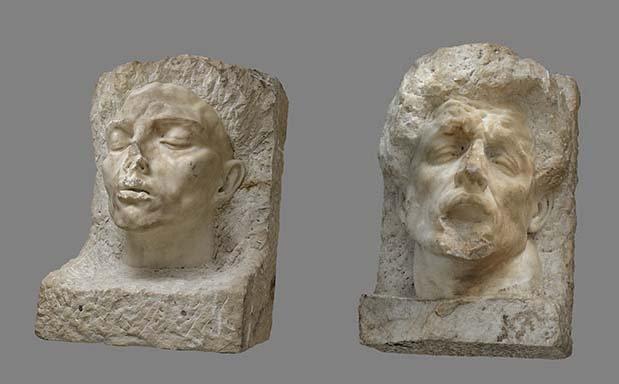After these finds had been documented by the Landesdenkmalamt (Berlin Monument Authority) and Thomas Lucker of RAO – Restaurierung am Oberbaum restoration workshop had completed its report, the objects are now being presented to the public in the exhibition area of Kunsthaus Dahlem until January 2021 (with a short intermission for installation of another exhibition; the facility is closed from October 19th to 30th 2020).
The attribution of the second work and more precise study of the circumstances of the find are ongoing. Arno Breker, for whom what is now the Kunsthaus Dahlem was built from 1939 to 1942 to use as a studio, worked here only briefly. In 1943, the building had already been damaged by air raids, making continued use impossible.
After the war, Soviet occupation troops moved into the building for several weeks and from the summer of 1945 it served for a year as an office of the United States military administration. In 1946, the works by Breker that were still on the grounds were transferred to the nearby collecting point at the Völkerkunde-Museum (Ethnological Museum) in Dahlem. It is therefore reasonable to assume that these two sculptures were buried when the American occupying forces were cleaning up the site.
About the attributed work Arno Breker: Romanichel (1940),
Marble, 90 x 68 x 60 cm
The marble sculpture is an outsized portrait head, though only the face and the front part of the neck have been carved from the stone block. The surface of this carefully elaborated face is finely polished, while its hair, sides, and lower area are roughly jagged. The object has points for holding a pouncing machine. Apparently, the transfer was made from a (plaster) model of the same size. Corresponding marking points for the transfer process are also visible. The object shows damage on the nose and around the mouth. It was identified with the help of historical photographs as Romanichel (1940) by Arno Breker. Most likely, it was made at the site of Breker’s former studio, which is now Kunsthaus Dahlem. It is considered as on of Breker’s most famous portrait torsi.
The figure is a young Sinto or Rom whose name is not known. Breker met him in Paris in the 1920s and portrayed him several times. At the end of the 1920s a first version was created. Breker wrote of his encounter with the young man, who moved in the orbit of friends around Jean Cocteau: “His head fascinated me immediately; the sessions began the same day. I modeled no fewer than seven busts on him. […] One of my friends in Paris was a cameraman who saw two of these new busts in my studio. He was excited by its strange expression, which was reminiscent of Amenhotep, and the model was sought out for screen tests.”
Compared to the impressionistic first formulation, the later version has been smoothed out in the classicist manner and therefore corresponds well to the context of Breker’s work of the 1930s. It is not known what moved Breker to take up the subject again around 1940; perhaps it was the opportunity to execute the head now in a monumental format. However, several sculptures of similar design are known today, including Demetra Messala of 1933 and Andacht (Devotion) of 1937. Romanichel, however, even exceeds their expressivity.
About the unidentified work
Marble, 86 x 57 x 52 cm
The second sculpture shows a larger than life head in white marble. Again, only the face and the front part of the neck have been carved from the stone block. The surface of this carefully elaborated face is finely polished, while its hair, sides, and lower area are roughly jagged. The plinth is heavily damaged – most likely due to acts of violence before the work was burried.
Stylistically, the work resembles the Romanichel. It shows a male head with closed eyes and the mouth wide open. Ongoing research will focus on the identification of the piece and the explanation of the exact circumstances of the find.
The Kunsthaus Dahlem opened in 2015 in the former state studio of the sculptor Arno Breker, right next to the Grunewald and in the direct vicinity of the Brücke Museum. Under the artistic directorship of Dr. Dorothea Schöne, the institution is dedicated to German postwar modernism in the East and West, with an express concentration on sculpture. In addition to exhibitions, there are regular curator tours, concerts, readings, lectures, and workshops.
In light of the contentious history of the site, one special focus of its programming is on the sometimes-problematic relationship of art and politics. The institution actively strives to come to terms with National Socialist history, both by researching the history of its own building and its use and by scholarly study of the life and work of artists subjected to condemnation and persecution during the National Socialist dictatorship.
The building was built between 1939 and 1942 as part of the construction efforts for the planned capital Germania and today is the only artist’s studio from the National Socialist era that is permanent accessible. In 1949, the sculptor Bernhard Heiliger moved into the east wing of the building, where he lived and worked until his death in 1995. Today’s visitors will find a selection of his works both in the exhibition space and in the adjacent sculpture garden.
In the 1970s, workspaces for artists were created in Breker’s former studio, which until 2008 were awarded by the Deutscher Akademischer Austauschdienst (DAAD; German Academic Exchange Service) and the Berlin Senate Department of Culture. Renowned artists from all over the world worked in these spaces, such as Armando, Ouhi Cha, Jimmie Durham, Ayşe Erkmen, Dorothy Iannone, Jean Robert Ipoustéguy, Emmett Williams, Zhu Jinshi, and Qin Yufen.
The organization responsible for the Kunsthaus Dahlem is the Atelierhaus Dahlem gGmbH. The Kunsthaus is supported by an institutional grant from the Senate Department for Culture and Europe of the Land of Berlin.
Research and inventarization on the works is conducted in cooperation with
Senatsverwaltung für Kultur und Europa Landesdenkmalamt Berlin
and with kind support by
RAO Restaurierung am Oberbaum Freundeskreis Kunsthaus Dahlem – Bernhard Heiliger e.V.
Kunsthaus Dahlem
Käuzchensteig 8-12
14195 Berlin
Telefon: +49 (30) 832272-58
Telefax: +49 (30) 832272-59
http://www.kunsthaus-dahlem.de
Telefon: +49 (179) 4963497
E-Mail: dh@segeband.de
Telefon: +49 (30) 83227258
E-Mail: info@kunsthaus-dahlem.de
![]()

